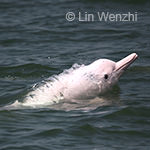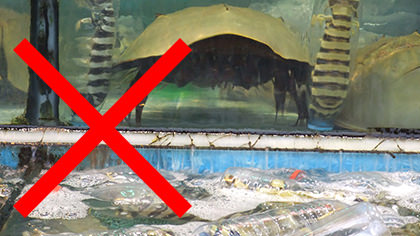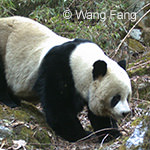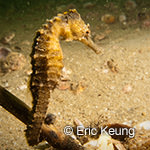

|
Scientific Name: |
|
IUCN Conservation Status Mangrove horseshoe crab, Southern (Malaysian) horseshoe crab – Data Deficient (1996) |
| Estimated Wild Population: Unknown |
| Life Span: About 20 years |
| Distribution: Sand and mudflat for juveniles; sea bottom of 20-30 meters in depth for adults |
Horseshoe Crabs are an ancient group of marine chelicerates. Although its name has the word "crab", it is not genetically related to crabs. Rather, they have closer lineages with trilobites and arachnids (e.g. spiders and scorpions).
The body of the horseshoe crab is distinctly divided into three parts: an anterior large prosoma (head and thorax); a posterior, small and hexagonal opisthosoma (abdomen); as well as a long tail (telson). The prosoma and opisothosoma together look like a helmet, the dorsal front part of which two compound eyes are located. Under the "helmet" are six jointed legs, mouth and gills in the form of five overlaid flaps. The long, straight and rigid tail allows it to balance its body and flip itself over when it is turned upside down.
During breeding season, horseshoe crabs move to shallow coastal waters. Males select females and cling onto her back. The female digs a hole in the sand and lays her eggs while the male fertilizes them at the same time. The female can lay between 60,000 and 120,000 eggs in batches of a few thousand. However, the survival rate of a horseshoe crab in its first year is only one in ten thousand.

The horseshoe crab has a significant evolutionary and biological value. The horseshoe crab has existed since the Late Ordovician Period (475 million years ago), about 230 million years prior the early appearance of dinosaurs on Earth. Body forms of the horseshoe crab have changed very little over the years and thus the species is considered "living fossil". The extract of horseshoe crab blood can be made into Tachypleus Amebocyte Lysate (TAL) which is an efficient detector for bacterial endotoxins. It is widely used in testing drugs, products and devices that come in contact with human blood in medical uses and has a tremendous contribution to our medical development.
| Estimated Wild Population: Unknown Wild Population in Hong Kong: The wild population of horseshoe crab had dropped by over 90% between 2002 and 2009. A study in 2012 indicated that the number of local juvenile horseshoe crabs only amounts to less than 10,000. (4,500 juvenile Tri-spine horseshoe crabs and 3,000 mangrove horseshoe crabs) |
IUCN Red List of Threatened Species: EX
EW
CR
EN
VU
NT
LC
DD
American horseshoe crab – Vulnerable (2016) |
 |
 |
 |
|---|---|---|
| Human exploitation for food, conch fishery baits and medical uses | Loss of spawning and nursery beaches owing to urban development and pollution | Being entangled and killed by fishing nets or gears abandoned in the sea |

About
- Provide secondary school students with an opportunity to take care of juvenile horseshoe crabs that were artificially-bred by City University of Hong Kong, and collectively releasing them into the wild after about six months.
Objectives
- To teach students about wildlife conservation
- To help replenish wild populations of horseshoe crabs in Hong Kong

About
- This is the largest juvenile horseshoe crab population survey in Hong Kong. Starting from July 2014, students, members from the commercial sectors and general public will participate in conducting population survey at 17 spawning and nursery sites of horseshoe crabs in Hong Kong.
Objectives
- To document the amount and distribution of juvenile horseshoe crabs in Hong Kong
- To identify any trend of population change over time

- OPCFHK has been allocating funds to support horseshoe crab scientific research and conservation projects, including research in artificial breeding, wild release methodology and effectiveness, as well as habitat conservation, etc.
- In 2011, OPCFHK sponsored the first "International Workshop on the Science and Conservation of Asian Horseshoe Crabs" in Hong Kong, gathering a group of internationally acclaimed experts to develop a strategy to conserve horseshoe crabs in Asia
- In 2014, OPCFHK established the Mainland, Taiwan and Hong Kong Horseshoe Crab Conservation Alliance with other institutions, which enabled us to integrate regional conservation efforts on horseshoe crab and protect the coastal ecosystem

- The Foundation organises mudflat clean-ups regularly, involving members of general public or corporates to restore the habitats of horseshoe crabs.
 |
 |
|---|---|
|
Say NO to Buying Horseshoe Crabs |
Join Friends of the Foundation |
 |
|
|
Funding Research and Conservation Project |


